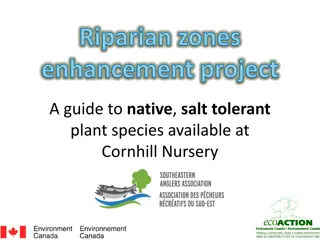Infectious Endocarditis
A 22-year-old female patient with a history of infected endocarditis and recent dental procedure presents with high-grade fever, chills, shortness of breath, and arthralgia. Examination reveals a pan systolic murmur and tachycardia. Echocardiography shows mitral regurgitation with vegetation on the
1 views • 32 slides
Integrated Approach for Stream Network Development and Riparian Zone Analysis
This project aims to build a seamless stream network, apply riparian zone delineation tools, and assess various environmental factors affecting stream ecosystems. The integration of data and analysis tools provides a comprehensive understanding of stream dynamics and habitat potential.
1 views • 26 slides
CYGNSS Earth Venture Mission Overview
The CYGNSS Earth Venture Mission involves eight satellites in low Earth orbit designed to measure near-surface wind speed over oceans and map soil moisture and inland water under vegetation on land. Launched in December 2016, the mission has been successful, currently in its extended phase with seve
2 views • 9 slides
Washington State Natural Resources Conservation Service STAC Presentation Update
Presentation highlights the latest updates on various conservation programs and fund allocations in Washington State. Includes details on ACEP-ALE signup, Riparian Buffer Fund Pool, Best Management Strategies, and Act Now Fund Pools for FY24, along with information on the Regional Conservation Partn
2 views • 10 slides
Understanding Grazing Systems and Veld Types in Animal Production
This educational material covers various grazing systems, veld types, and the impact of different grazing animals on the vegetation. It discusses the importance of understanding veld types such as sweetveld, sourveld, and mixed-veld, and how factors like rainfall and soil texture influence these cla
0 views • 15 slides
Natural Vegetation and Wildlife Sanctuaries in India
The natural vegetation in India varies based on climatic and topographical factors, leading to diverse flora such as Evergreen Rain Forests, Monsoon Deciduous Forests, and Desert ecosystems. The Himalayas showcase vegetation changes with altitude, while factors like soil and topography influence veg
2 views • 39 slides
Major Vegetation of Pakistan - Overview and Characteristics
Vegetation in Pakistan varies from tropical forests to thorn forests, each with unique adaptations to the climate. Natural and local vegetation types like tropical dry deciduous forests and thorn forests are described, highlighting plant adaptations and environmental factors influencing growth.
0 views • 20 slides
Understanding Biomes: Climate, Vegetation, and Adaptations
Biomes are vast regions defined by climate, plant and animal communities. Factors like climate, geography, and vegetation impact the unique characteristics of each biome. Understanding biomes involves knowledge of climate, geography, vegetation adaptations, and animal diversity. Changes in one part
0 views • 23 slides
Understanding Sand Dune Vegetation: Citizen Science Survey
Conduct a vegetation survey to track changes in sand dune ecosystems over time. Monitor bare sand cover, vegetation types, plant species health indicators, and nutrient levels. Learn how to conduct the survey to help inform management decisions and preserve dune environments effectively.
0 views • 10 slides
Financial Strategy for National Strategy on Climate Change and Vegetation Resources
The Financial Strategy for the ENCCRV encompasses three phases - Preparation, Implementation, and Payment based on results, with a focus on addressing deforestation, forest degradation, and promoting sustainable vegetation management. Funding sources include international funds, private sector inves
0 views • 9 slides
Successful Channel Modification Techniques and Benefits
Channel modification projects aim to accelerate the recovery of stable, sustainable channel forms in dynamic balance with sediment, large wood, and flow regimes. Successful modifications lead to improved habitat quality, stability, and diversity, benefiting sediment transport and riparian zones. Phy
0 views • 15 slides
Exploring Kamloops: Landforms, Climate, Vegetation, and Environmental Issues
Discover the diverse landscape of Kamloops with its mountains, lakes, and unique vegetation. Learn about the hot summers and cold winters, ideal for activities like golfing and snowshoeing. However, forest fires pose a significant environmental issue, impacting animals, humans, and habitats. Explore
0 views • 9 slides
VELCO Vegetation Management Plan Overview 2021
Detailed analysis of the proposed vegetation management plan by VELCO for 2021, including comparisons between planned and actual units, herbicide usage by chemical and line, Rodeo usage by year, scheduled maintenance areas, and ultra-low volume foliar treatments. The data visualizations provide insi
0 views • 12 slides
Green Infrastructure Approach for Conservation of Tangipahoa and Tchefuncte Rivers
Using a green infrastructure approach, our organization is managing stormwater and nonpoint source pollution on the Tangipahoa and Tchefuncte Rivers in Southeast Louisiana. By conserving valuable natural areas and working with private landowners, we aim to create riparian buffers and enhance water q
1 views • 19 slides
Understanding Vegetation Dynamics with LPJ-GUESS Modeling
Explore the modeling of vegetation dynamics using LPJ-GUESS, covering stand to global scale approaches, management needs, and ecosystem-scale considerations. Discover the characteristics of ecosystem-scale modeling and the inputs and outputs of LPJ-GUESS for simulating vegetation dynamics.
0 views • 14 slides
Promoting Effective Trans-basin Water Management Cooperation Among Riparian Nations
This paper presented by Dan Tarlock discusses the importance of effective trans-basin water management cooperation among riparian nations. It outlines the challenges, such as moving from formal to effective cooperation, and emphasizes the need for measurable benefits and a strong legal framework. In
0 views • 8 slides
Sepulveda Basin Reserve: Bull Creek Ecological Study
Sepulveda Basin Reserve: Bull Creek conducted a study focusing on riparian vegetation, with a special analysis of native vs. exotic species diversity. The research revealed challenges such as homeless populations affecting transecting efforts. Results indicated a significant impact of native species
0 views • 8 slides
Economic Analysis of Climate-Induced Flood Adaptation in Koshi Basin, Nepal
This project aims to assess the impact of climate-induced floods on agriculture in the Koshi basin of Terai, Nepal. By evaluating flood risk, economic costs, and different adaptation options, the study seeks to enhance resilience in the face of increasing flood occurrences catalyzed by climate chang
0 views • 9 slides
Understanding Natural Vegetation and Wildlife Resources
Natural vegetation and wildlife play a crucial role in the biosphere, providing essential resources and maintaining ecological balance. The interaction between the lithosphere, hydrosphere, and atmosphere creates the biosphere where living organisms thrive. Plants offer timber, oxygen, and other val
0 views • 16 slides
Riparian Area Management Regulations and Standards Overview
Riparian area management has evolved over the years with regulations addressing timber harvest impacts on fish habitat and water quality. Key aspects include protection standards, considerations of economic feasibility, and the importance of preserving fish habitat for sustainable ecosystem health.
0 views • 55 slides
Overview of Vegetation Index EDR Data Products and Team Members
This content discusses the JPSS STAR Algorithm and Data Products (ADP) Beta Review related to Vegetation Index EDR, including details on various data products, team members, beta maturity definition, and background of VI EDR product. It provides insights into the TOA-NDVI and TOC-EVI vegetation indi
0 views • 33 slides
Insights into Vegetation Dynamics and Function in Ecosystems
Explore the complexities of vegetation dynamics, composition, structure, and function in various ecosystems through discussions on disturbance, wetlands, hydrology, and ecosystem services. Engage in ongoing dialogues about vegetation classification schemas and practical methods like traits mapping t
0 views • 9 slides
Long-term Ecosystem Monitoring Project Status Report
The Long-term Ecosystem Monitoring Project, led by Diane Burbank, provides an overview of a 50-year monitoring effort focusing on the effects of broad-scale environmental changes. The project involves sampling soil, vegetation, lichen, and down woody material at 20 plots every 10 years. Site selecti
0 views • 12 slides
Enhancing Riparian Zones: A Guide to Native Salt-Tolerant Plants at Cornhill Nursery
This guide provides information on various native salt-tolerant plant species available at Cornhill Nursery for enhancing riparian zones. It includes details on roses, fruiting shrubs like elderberry and red raspberries, shrubs such as witch hazel and wild raisin, deciduous trees like paper birch an
0 views • 15 slides
Managing Invasive Plants and Wildfire in Arizona
The Invasive Plant Grant Program in Arizona is actively combating invasive plant species to prevent wildfires and preserve ecosystems. State funds are allocated for projects targeting species like Saltcedar and Buffelgrass. Grant criteria and projects in 2019 and 2020 reveal a focus on eradicating n
0 views • 19 slides
Understanding Global Ecosystems and Climate Influences
Global ecosystems are defined by dominant vegetation types and are influenced by factors like climate, atmospheric circulation, altitude, relief, and ocean currents. The distribution and characteristics of ecosystems are shaped by global atmospheric circulation patterns, creating distinct belts of v
0 views • 18 slides
Optimizing Riparian Buffers for Thermal Protection in Teanaway River Watershed
Explore the study comparing optimized riparian buffer designs with fixed-width buffers in non-fish bearing streams of the Teanaway River watershed, focusing on maximizing thermal energy reductions with considerations for channel orientation and forest density. By utilizing NetMaps and thermal energy
0 views • 24 slides
Enhancing Utility Rights of Way with Integrated Vegetation Management
Integrated Vegetation Management (IVM) is a systematic approach that promotes low-growing plant communities to resist invasive tree species. It involves continual improvement through a cycle of information gathering, planning, implementation, and review. By employing IVM in utility rights-of-ways, o
0 views • 21 slides
Insights from Round Robin Science Lessons Learned
Discover the latest advances in science including insights on the arctic carbon budget, disturbance quantification, vegetation changes, permafrost modeling, and remote sensing processing workflows. Dive into the complexities of carbon mapping, water dynamics, vegetation responses, and trait algorith
0 views • 8 slides
Conservation Plan for Aquatic Habitat Restoration in New Braunfels
This plan outlines various projects aimed at managing aquatic habitats in New Braunfels for the restoration and preservation of native species such as the fountain darter. It includes objectives like flow manipulation, non-native vegetation control, and restoration of aquatic vegetation in the Comal
0 views • 17 slides
Ecological Consequences Assessment for Conservation Areas
Determining the ecological consequences of various scenarios is crucial for conservation efforts. The assessment focuses on changes in geomorphology, physico-chemical properties, fish populations, macroinvertebrates, and riparian vegetation. By evaluating scenarios based on ecological significance,
0 views • 11 slides
River Restoration Strategies in Oregon: ES407 Senior Seminar Working Group
Explore the efforts of the ES407 Senior Seminar Working Group from Western Oregon University in Monmouth as they delve into river restoration strategies, watershed assessment, salmonid habitat restoration, fluvial hydrology, and more. Discover the historical framework shaping modern interventions an
0 views • 7 slides
Water Supply Hazards and Management Insights
Understanding catchment hazards for water supplies is crucial for effective management. This report discusses E. coli values, turbidity concerns, fauna impact, and algal blooms. It also suggests measures to address these issues, such as riparian planting, stock management, and sediment control in ag
0 views • 10 slides
Marine Aquaculture Impacts on Submersed Aquatic Vegetation
The document explores the impacts of structures and shading used in commercial shellfish mariculture activities on submersed aquatic vegetation, particularly seagrasses. It discusses the varying effects of mariculture structures on eelgrass density, productivity, and the potential habitat they provi
0 views • 11 slides
Monitoring Forest Cover Disturbances During Natural Hazards by Meteorological Satellites
Ecosystem functioning relies on energy, water, and carbon fluxes regulated by vegetation and soil properties. This study focuses on monitoring forest cover disturbances before, during, and after natural hazards using meteorological satellites. It involves analyzing land surface temperature, evapotra
0 views • 37 slides
Understanding LiDAR Backscattering and Vegetation Structure Analysis
Exploring the intricacies of LiDAR pulse backscattering in relation to vegetation structure analysis using photogrammetry-derived data. Discussing the technical aspects of pulsed LiDAR sensors, hot-spot view geometry, time-stamped photons, vicarious reflectance calibration, and challenges in radiome
1 views • 19 slides
Proposed Buffer Mitigation Rules Overview
The proposed buffer mitigation rules aim to address nutrient loading by adopting alternative measures to replace lost riparian buffers. The rules include options for location of mitigation, accounting for buffer and nutrient offset, and various optional methods like coastal headwater stream mitigati
0 views • 21 slides
Distributional Conflict over Blue Nile River Basin and Its Implication for Institutional Change
The study by Mebratu Alemu explores the distributional conflict among riparian countries over the Blue Nile River Basin, highlighting the challenges and implications for institutional change. Through analyzing property rights changes and investigating drivers behind conflicts and cooperation, the re
0 views • 27 slides
Biodiversity Mitigation in Victoria, Australia: A Case Study
Exploring the biodiversity offsetting system in Victoria, Australia, this case study focuses on the state's efforts to achieve Biodiversity Net Gain. The modules cover topics such as ecological vegetation classes, habitat condition scores, offset implementation, and the evolution of offsetting pract
0 views • 41 slides
Evaluation of Communications Needs for Tree Planting & Maintenance at Chesapeake Riparian Forest Buffer Workshop
This evaluation project aims to gather and synthesize existing products and campaigns, along with direct feedback, to assess the communications needs of partners, practitioners, and technical service providers. The workgroup consists of members from various organizations who utilized methods such as
0 views • 14 slides







































